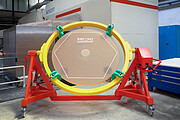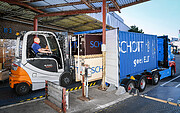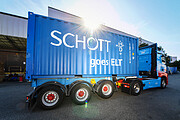Press Release
Last segment blank of the world’s largest telescope mirror successfully delivered
27 June 2024
The European Southern Observatory’s Extremely Large Telescope (ESO’s ELT), under construction in the Chilean Atacama Desert, is one step closer to completion. German company SCHOTT has successfully delivered the blank for the last of the 949 segments commissioned for the telescope’s primary mirror (M1). With a diameter of more than 39 metres, M1 will be by far the largest mirror ever made for a telescope.
Too large to be made from a single piece of glass, M1 will consist of 798 hexagonal segments, each about five centimetres thick and 1.5 metres across, working together to collect tens of millions of times as much light as the human eye. An additional 133 segments have been produced to facilitate the maintenance and recoating of the segments once the telescope is operational. ESO has also procured 18 spare segments, bringing the total number to 949.
The M1 blanks, shaped pieces of material that are later polished to become the mirror segments, are made from ZERODUR®, a low-expansion glass-ceramic material developed by SCHOTT and optimised for the extreme temperature ranges at the ELT’s site in the Atacama Desert. This company has also manufactured the blanks of three other ELT mirrors — M2, M3, and M4 — at their facilities in Mainz, Germany.
“What ESO ordered from SCHOTT is more than just ZERODUR®,” says Marc Cayrel, Head of ELT Optomechanics at ESO. “In close collaboration with ESO, SCHOTT fine-tuned every single production step, tailoring the product to meet and often exceed the ELT’s very demanding requirements. The outstanding quality of the blanks was maintained throughout the mass production of more than 230 tonnes of this super-performing material. ESO is thus very thankful for the professionalism of the skilled teams at SCHOTT, our trusted partner.”
Thomas Werner, ELT Project Lead at SCHOTT, says: “Our entire team is thrilled to conclude what has been the largest single order of ZERODUR® in the history of our company. For this project, we successfully concluded the serial production of hundreds of ZERODUR® mirror substrates, when we usually have a single-piece operation. It’s been an honour for all of us to play a part in shaping the future of astronomy.”
Once cast, all segments follow a multi-step, international journey. After a slow cooling and heat treatment sequence, the surface of each blank is shaped by ultra-precision grinding at SCHOTT. The blanks are then transported to French company Safran Reosc, where each of them is cut into an hexagon shape and polished to a precision of 10 nanometres across the entire optical surface — meaning the surface irregularities of the mirror will be less than one thousandth of the width of a human hair. Also involved in the work done on the M1 segment assemblies are: Dutch company VDL ETG Projects BV, which is producing the segment supports; the German-French FAMES consortium, which has developed and is finalising manufacturing for the 4500 nanometric-accuracy sensors monitoring the relative position of each segment; German company Physik Instrumente, which designed and is manufacturing the 2500 actuators able to position the segment to nanometric precision; and Danish company DSV, which is in charge of transporting the segments to Chile.
Once polished and assembled, each M1 segment is shipped across the ocean to reach the ELT Technical Facility at ESO’s Paranal Observatory in the Atacama Desert — a 10 000-kilometre journey that over 70 M1 segments have already completed. In Paranal, only a few kilometres away from the construction site of the ELT, each segment is coated with a silver layer to become reflective, after which it will be carefully stored until the telescope’s main structure is ready to receive them.
When it starts operating later this decade, ESO’s ELT will be the world’s largest eye on the sky. It will tackle the biggest astronomical challenges of our time and make as-yet unimaginable discoveries.
More information
The European Southern Observatory (ESO) enables scientists worldwide to discover the secrets of the Universe for the benefit of all. We design, build and operate world-class observatories on the ground — which astronomers use to tackle exciting questions and spread the fascination of astronomy — and promote international collaboration for astronomy. Established as an intergovernmental organisation in 1962, today ESO is supported by 16 Member States (Austria, Belgium, Czechia, Denmark, France, Finland, Germany, Ireland, Italy, the Netherlands, Poland, Portugal, Spain, Sweden, Switzerland and the United Kingdom), along with the host state of Chile and with Australia as a Strategic Partner. ESO’s headquarters and its visitor centre and planetarium, the ESO Supernova, are located close to Munich in Germany, while the Chilean Atacama Desert, a marvellous place with unique conditions to observe the sky, hosts our telescopes. ESO operates three observing sites: La Silla, Paranal and Chajnantor. At Paranal, ESO operates the Very Large Telescope and its Very Large Telescope Interferometer, as well as survey telescopes such as VISTA. Also at Paranal ESO will host and operate the Cherenkov Telescope Array South, the world’s largest and most sensitive gamma-ray observatory. Together with international partners, ESO operates ALMA on Chajnantor, a facility that observes the skies in the millimetre and submillimetre range. At Cerro Armazones, near Paranal, we are building “the world’s biggest eye on the sky” — ESO’s Extremely Large Telescope. From our offices in Santiago, Chile we support our operations in the country and engage with Chilean partners and society.
Links
- Find out more about ESO's Extremely Large Telescope (ELT) on our dedicated website and press kit
- More detailed information on M1
- More information on SCHOTT’s work on the ELT
- For journalists: subscribe to receive our releases under embargo in your language
Contacts
Bárbara Ferreira
ESO Media Manager
Garching bei München, Germany
Tel: +49 89 3200 6670
Cell: +49 151 241 664 00
Email: press@eso.org
Elisabeth Harvey
Marketing & Communications – SCHOTT AG
Mainz, Germany
Email: elisabeth.harvey@schott.com
About the Release
| Release No.: | eso2410 |
| Name: | Extremely Large Telescope |
| Type: | Unspecified : Technology |
| Facility: | Extremely Large Telescope |
Our use of Cookies
We use cookies that are essential for accessing our websites and using our services. We also use cookies to analyse, measure and improve our websites’ performance, to enable content sharing via social media and to display media content hosted on third-party platforms.
ESO Cookies Policy
The European Organisation for Astronomical Research in the Southern Hemisphere (ESO) is the pre-eminent intergovernmental science and technology organisation in astronomy. It carries out an ambitious programme focused on the design, construction and operation of powerful ground-based observing facilities for astronomy.
This Cookies Policy is intended to provide clarity by outlining the cookies used on the ESO public websites, their functions, the options you have for controlling them, and the ways you can contact us for additional details.
What are cookies?
Cookies are small pieces of data stored on your device by websites you visit. They serve various purposes, such as remembering login credentials and preferences and enhance your browsing experience.
Categories of cookies we use
Essential cookies (always active): These cookies are strictly necessary for the proper functioning of our website. Without these cookies, the website cannot operate correctly, and certain services, such as logging in or accessing secure areas, may not be available; because they are essential for the website’s operation, they cannot be disabled.
Functional Cookies: These cookies enhance your browsing experience by enabling additional features and personalization, such as remembering your preferences and settings. While not strictly necessary for the website to function, they improve usability and convenience; these cookies are only placed if you provide your consent.
Analytics cookies: These cookies collect information about how visitors interact with our website, such as which pages are visited most often and how users navigate the site. This data helps us improve website performance, optimize content, and enhance the user experience; these cookies are only placed if you provide your consent. We use the following analytics cookies.
Matomo Cookies:
This website uses Matomo (formerly Piwik), an open source software which enables the statistical analysis of website visits. Matomo uses cookies (text files) which are saved on your computer and which allow us to analyze how you use our website. The website user information generated by the cookies will only be saved on the servers of our IT Department. We use this information to analyze www.eso.org visits and to prepare reports on website activities. These data will not be disclosed to third parties.
On behalf of ESO, Matomo will use this information for the purpose of evaluating your use of the website, compiling reports on website activity and providing other services relating to website activity and internet usage.
Matomo cookies settings:
Additional Third-party cookies on ESO websites: some of our pages display content from external providers, e.g. YouTube.
Such third-party services are outside of ESO control and may, at any time, change their terms of service, use of cookies, etc.
YouTube: Some videos on the ESO website are embedded from ESO’s official YouTube channel. We have enabled YouTube’s privacy-enhanced mode, meaning that no cookies are set unless the user actively clicks on the video to play it. Additionally, in this mode, YouTube does not store any personally identifiable cookie data for embedded video playbacks. For more details, please refer to YouTube’s embedding videos information page.
Cookies can also be classified based on the following elements.
Regarding the domain, there are:
- First-party cookies, set by the website you are currently visiting. They are stored by the same domain that you are browsing and are used to enhance your experience on that site;
- Third-party cookies, set by a domain other than the one you are currently visiting.
As for their duration, cookies can be:
- Browser-session cookies, which are deleted when the user closes the browser;
- Stored cookies, which stay on the user's device for a predetermined period of time.
How to manage cookies
Cookie settings: You can modify your cookie choices for the ESO webpages at any time by clicking on the link Cookie settings at the bottom of any page.
In your browser: If you wish to delete cookies or instruct your browser to delete or block cookies by default, please visit the help pages of your browser:
Please be aware that if you delete or decline cookies, certain functionalities of our website may be not be available and your browsing experience may be affected.
You can set most browsers to prevent any cookies being placed on your device, but you may then have to manually adjust some preferences every time you visit a site/page. And some services and functionalities may not work properly at all (e.g. profile logging-in, shop check out).
Updates to the ESO Cookies Policy
The ESO Cookies Policy may be subject to future updates, which will be made available on this page.
Additional information
For any queries related to cookies, please contact: pdprATesoDOTorg.
As ESO public webpages are managed by our Department of Communication, your questions will be dealt with the support of the said Department.



